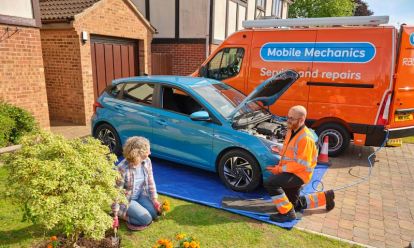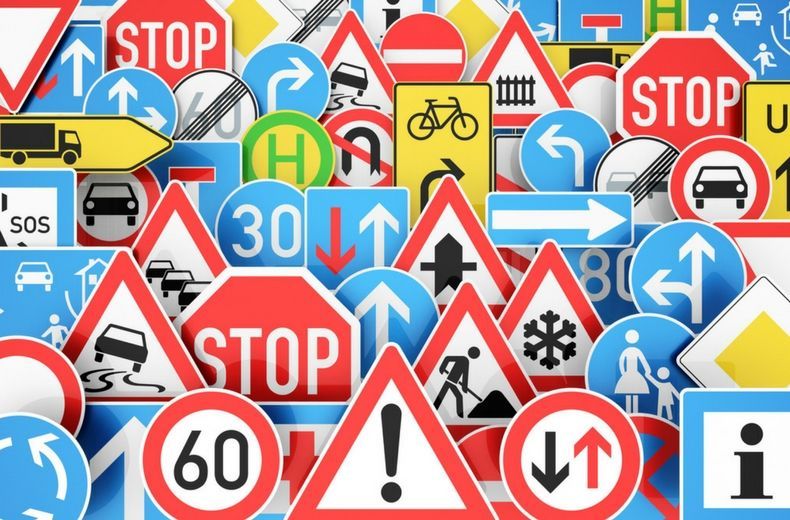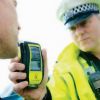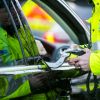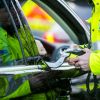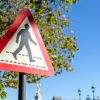Research suggests over three-quarters of UK drivers never return to the motoring bible after passing their test.
Are you one of the thousands of drivers who directly contravene these most-forgotten road rules every day?
Knowing the laws of the roads is vital for all who get behind the wheel of a vehicle
Is the Highway Code actually law?
No, taken alone the Highway Code is not the law. But many of its instructions are backed up by law and so have legal muscle behind them.
Those points supported by the law are clearly identified in the document by wording like ‘MUST’, ‘MUST NOT’, rather than ‘should’ or ‘should not’.
Failure to comply with the other rules of the Code can’t directly cause you to be fined, prosecuted or disqualified – but the advice it offers can be used as evidence in any court, to establish liability.
1. Don’t wait or park on yellow zig zags
Found outside entrances to schools, hospitals, police and fire stations, these areas are to be avoided for everyone’s safety.
You will not, however, be issued a Penalty Charge Notice (PCN) unless these lines are accompanied by a sign, detailing the restriction.
Sign or not though, it is never advisable for motorists to park on these restrictions. Find out more about where you can and can’t park with our handy guide.

RAC sale – up to 33% off*
• Roadside cover from £5.29 a month†
• We get to most breakdowns in 60 mins or less
• Our patrols fix 4/5 breakdowns on the spot

2. Always let out buses
The Code tells us to give priority to buses, coaches and trams when you can do so safely – particularly when they’re signalling to pull away from stops.
The truth is, it isn’t a legal requirement. Buses must indicate and wait for a gap in traffic like the rest of us.
But not only is it courteous to safely slow down and leave a good distance as soon as you see a larger vehicle’s signal, it also avoids confusion and the possibility of a large bus pulling into your path.
A related misdemeanour comes with use of bus lanes. As sensible as it might feel to use one to ease congestion when there’s not a bus in sight, you can and will be punished if you stray during times of operation.
3. Don’t cross double (centre-of-road) white lines
We’re forbidden by law from crossing double white lines in the middle of the road where the line nearest to us is solid. Still how many times do you see drivers straddling, or even pulling out into the oncoming lane?
The curveball here is that this practice is actually allowed in certain circumstances – although rarely the ones in which the rule is broken.
You can cross the lines if entering adjoining premises or a side road, or if safe, to overtake a pedal cycle, horse or road maintenance vehicle travelling at 10mph or under.
4. Avoid ‘undertaking’
Not the profession, but the much frowned-upon act of passing a vehicle on its near (left) side.
According to the Code, overtaking on this side is acceptable if you’re on a multi-lane carriageway in congested conditions, meaning the left lane is moving faster than the right.
It’s also OK if the vehicle in front is signalling to turn right.
Still this hardly accounts for all those times someone whooshes by you on the inside before you’ve had a safe chance to pull back into lane one.
There is no law itself against the act of undertaking, but it can count as an offence under careless or even dangerous driving.
5. Never ‘hog’ the middle lane
Middle-lane hogging is one of the biggest bugbears among drivers. It’s when vehicles remain in the middle lane longer than necessary, even when there aren’t any vehicles in the inside lane to overtake.
Many argue it’s safer to remain on a straight course than weaving in and out of lanes, and certainly common sense is generally applied by both drivers and the police.
But ultimately, rules are rules – the Code implicitly states you should return to the left-hand lane as soon as you safely pass.
READ MORE: Are you a middle-lane hogger? Here are the facts
6. Avoid all in-car distractions
We’re all aware of the legal requirement to keep hands well and truly off our mobile phones while in control of our vehicles. But how many of the Highway Code’s list of distractions to avoid are we squeaky clean on?
The Code reminds us that safe driving needs concentration, and to ‘avoid’ distractions when drivng.
In short, we’re regrettably probably all guilty of violating the Code on this front from time to time.
Read more: 13 driving myths uncovered
7. Use your parking lights at night
All vehicles must display parking lights – sidelights – when parked on a road (or lay-by) with a speed limit over 30mph.
If the road has a speed limit of 30mph or less, you don’t need to leave on your sidelights, as long as your spot is a recognised parking bay or lay-by, or you’re facing in the direction of the traffic flow, close to the kerb, and at least 10 metres from the nearest junction.
This one’s law, and you’re technically eligible for a fine if caught – although a common sense is often applied by the police.
8. Don’t hold up long queues of traffic
We’re probably more likely to say we’re the victim, rather than the perpetrator of this Highway Code no-no, but it’s regularly not followed.
It’s a particular problem among larger or slower-moving vehicles, which are politely asked to frequently check their mirrors and pull over – if necessary and safe – to let traffic pass. Do they always though?
READ MORE: The real causes of motorway traffic and how to stop it
9. Inadequate (or excessive) indicating
We use our indicators to advise other road users before we change direction, stop or move off.
But as we know, there are several ways in which incorrect indicator use can cause confusion - from failure to signal, forgetting to cancel it after a turn, and signalling too early or too late.
We’re reminded that “signalling does not give you priority” – and not to assume that someone will allow us space just because we want to move into it. Solid advice.
10. Flashing headlights inappropriately
The Code states we should only ever flash headlights to let other road users know that we’re there – never to intimidate or try to convey any other sort of message.
Importantly, we should never make the assumption that another driver flashing their headlights is a signal inviting us to proceed.
11. Hands off that horn
Another widely-ignored law found in the Code centres on inappropriate horn use. While many drivers tend to use their horn in times of frustration, the Code says it should only be used to warn other road users of our presence, and shouldn’t be used ‘aggressively’.
It adds that you MUST NOT use your horn while stationary on the road or when driving in a built-up area between 11.30pm and 7.00am.
12. Driving over painted mini-roundabouts
Another we’ve probably all been guilty of. When faced with just you and the road ahead, making a deliberate circle can seem a tad pointless.
Understandably though, it’s not acceptable practice under the Code, and remains one of the most widespread misdemeanours on local roads.
This one is law and you could be subject to a Fixed Penalty Notice if caught, leave a comment below if this has happened to you.
READ MORE: Roundabouts – how to deal with them and pass your test
13. Turn off your engine if parked
Even if you’re just popping out for a couple of minutes, you can’t leave a parked vehicle unattended with the engine running, or leave it running unnecessarily while stationary on a public road.
OK, you wouldn’t really want to do this anyway for fear of someone jumping in and heading off in your pride and joy – but so you know, it’s against the law. One to remember when warming up the car on an icy morning - don’t get fined for de-icing your car.
14. Turn off your fog lights
Fog lights are only to be used when visibility is “seriously reduced”. This is usually taken to mean when visibility is less than 100 metres.
Leave them on as a luxury when visibility improves and you might dazzle other road users, breaking the both the law and the Highway Code in the process.
Find out more about when to use your fog lights.
READ MORE: How to check your lights and bulbs
15. Check before opening a door
The Highway Code states “you MUST ensure you do not hit anyone when you open your door. Check for cyclists or other traffic.”
16. Keep your distance in tunnels
Another that passed a few of us by. If you have to stop in a tunnel, you’re encouraged by the Code to leave at least a 5-metre gap between you and the vehicle in front, primarily to account for the reduced or altered visibility levels.
The obvious problem here is that this becomes difficult if traffic has been slow and more ‘nose-to-tail’ before a stop is necessitated. Still, be wary as it’s in the Code.
When can’t you use a bus lane?
All bus lanes have blue signs signalling their times of operation, which can vary significantly from road to road. By times of operation, we mean the periods within which only buses can drive in the lanes.
The sign will usually show a time period, and the days of the week when restrictions for non-buses are to be observed.
Sometimes they’ll show two sets of times (e.g. Mon-Fri 7.30 – 9.30am, 3.30 – 6.30pm).
If there are no times are shown on the sign then the lane is in operation 24 hours a day and can’t be used at any point by unauthorised vehicles.
When can you use a bus lane?
If you’re driving outside a bus lane’s operational hours, then you can use it as long as it’s safe to do so.
This will help ease traffic congestion, freeing up another lane for other vehicles.
Be aware that not using a bus lane when it’s safe to do so during your driving test could result in a marking down.
The bus lane’s blue sign will also show which other road users are permitted to use it…
Who can use a bus lane?
This all depends on the lane in question. While some are reserved entirely for buses (which must have a minimum of 10 seats including the driver), individual signs will signal which other road users may drive in them.
If they display the word ‘local’ then the lane can only be used by local bus services.
The following vehicles may be allowed to use bus lanes at indicated times if they are shown on the sign:
- Licensed London Taxis (Hackney carriages)
- Motorcycles (without side cars)
- Mopeds
- Scooters
- Tricycles (non-motorised, motorised under 450kg, not with side cars)
- Bicycles
What happens if you cross in to a bus lane?
In some circumstances you may be required to cross the solid white line into the bus lane. You should only drive into the lane when you have no other choice but to move over.
These cases could include; to avoid an obstruction in the road, to move out of the path of an emergency vehicle or to avoid an accident.
If you do enter a bus lane you must make sure you leave it again as soon as is safe to do so.
READ MORE: You can be fined for moving out of the way of an ambulance, here’s how to avoid it
What are the penalties for using bus lanes?
Bus lanes are introduced using Traffic Regulation Orders through powers issued under the Road Traffic Regulation Act 1984 and carry penalties for misuse.
Bus lanes are increasingly monitored by CCTV cameras to record any unauthorised vehicle driving or parking within the operational area.
The recordings are also checked to determine whether the lines may have been crossed in mitigating circumstances (e.g. to make way for emergency services).
If you’re caught using a bus lane during operational hours you could be liable to pay a penalty charge notice.
A PCN will be sent to the vehicle’s registered keeper containing details of the contravention, vehicle information and photographic evidence.
The amount payable varies across the country – being much higher in the capital and its Congestion Charge zone.
Can I appeal a bus lane violation?
If you think you’ve been wrongly penalised, you can appeal against the notice on the following grounds:
- the contravention didn’t occur
- the charge is more than the relevant amount
- a Fixed Penalty Notice had already been issued
- you are not the registered owner/hirer
- the vehicle was being hired out to someone who had signed a statement of liability
- it was being kept by a motor trader
- the vehicle was being used without consent
Be aware that failing to pay a PCN notice could result in your local authority taking action against you.
Want more useful content like this sent straight to your inbox?
Want to protect yourself against any losses following an accident? Get legal expenses insurance from just £15 a year with RAC Legal Care Plus.
Get a service or repair at home
RAC Mobile Mechanics can come to you, saving you the hassle of going to a garage.
